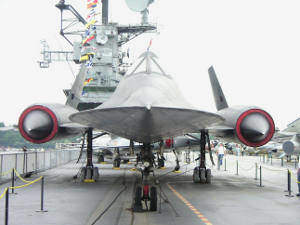
As you may have heard, the mythical Lockheed SR-71 Blackbird was a strategic reconnaissance aircraft able to fly at more than Mach 3 – Mach 3.3 ie around 3,500 km/h; or 1,900 kts; and at a maximum flight level of… FL 850 or 26 kilometers high!
The Blackbird indeed had a unique flight envelope with a particular doghouse plot (since she could not exceed 3.5 G), and an exceptionnal coffin corner limited by her CIT – Compressor Inlet Temperature of 427°C maximum.
This aircraft was also unique for her engines were two J58 ramjets fuelled by JP-7 especially refined for extreme flying purpose. This special fuel could drip and leak abundantly as the airframe made up of titanium was retracted while taxiing, and became airtight only when it got its operating shape while flying very fast and very high because of the air density, and surrounding pressure plus the heating caused by the air friction at such speeds. In short, the whole structure considerably expanded when airborne.
The irony – I heard it on the grapevine, or read it somewhere on the web – that titanium which turned into dark blue while flying (SR-71s probably deserved those unofficial other nicknames « Bluebird », or « Habu » viper) was « imported » from… USSR!
Pilots must have taken significant risks inherent in flying such an aircraft as mentioned in this previous post. These pilots used to fly over the USSR to take strategic reconnaissance photographs during the Cold war. They wore pressurized spacesuits so that their blood could not boil in case of decompression or ejection at such altitudes.
The Blackbird travelled faster than a rifle bullet, and the air friction could have melt aluminum-skinned aircraft. At Mach 3.2, fuel cycled behind the chine surface in order to cool the aircraft! The inner windshield temperature could reach 120°C even though a heavy-duty cooling system was on a full function. On landing, the outside temperature of the canopy could reach 300°C, and it must have been far beyond on the fuselage, and wing surfaces while flying at high speeds. The pilot could feel the heat behind his protective gloves!
Special thanks to Xavier Cotton for the Blackbird photos. Please, visit his website on http://www.passionpourlaviation.fr/


